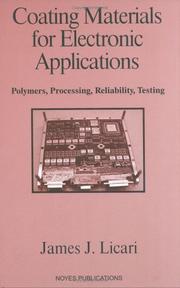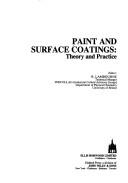| Listing 1 - 10 of 39 | << page >> |
Sort by
|
Book
ISBN: 0128172835 0128166711 9780128166710 9780128172834 Year: 2019 Publisher: Amsterdam, Netherlands ; Oxford, England ; Cambridge, Massachusetts : Elsevier Inc,
Abstract | Keywords | Export | Availability | Bookmark
 Loading...
Loading...Choose an application
- Reference Manager
- EndNote
- RefWorks (Direct export to RefWorks)
Protective coatings. --- Coating compositions --- Coatings --- Corrosion and anti-corrosives

ISBN: 1282013556 9786612013553 0080947042 0815516479 0815514921 1591245931 9781591245933 9780815514923 9780815516477 9781282013551 6612013559 9780080947044 Year: 2003 Publisher: Norwich, NY : Noyes Publications/William Andrew Publ.,
Abstract | Keywords | Export | Availability | Bookmark
 Loading...
Loading...Choose an application
- Reference Manager
- EndNote
- RefWorks (Direct export to RefWorks)
This first book in the Materials and Processes for Electronics Applications series answers questions vital to the successful design and manufacturing of electronic components, modules, and systems such as: - How can one protect electronic assemblies from prolonged high humidity, high temperatures, salt spray or other terrestrial and space environments? - What coating types can be used to protect microelectronics in military, space, automotive, or medical environments? - How can the chemistry of polymers be correlated to desirable physical and electrical properties? - How can a
Protective coatings. --- Electronics --- Materials. --- Electronic materials --- Coating compositions --- Coatings --- Corrosion and anti-corrosives --- Engineering
Book
ISBN: 0815506503 Year: 1977 Publisher: Park Ridge Noyes data corporation
Abstract | Keywords | Export | Availability | Bookmark
 Loading...
Loading...Choose an application
- Reference Manager
- EndNote
- RefWorks (Direct export to RefWorks)
Protective coatings --- Coating compositions --- Coatings --- Corrosion and anti-corrosives --- Testing --- Dyes
Periodical
ISSN: 87551985 Publisher: Pittsburgh, Pa
Abstract | Keywords | Export | Availability | Bookmark
 Loading...
Loading...Choose an application
- Reference Manager
- EndNote
- RefWorks (Direct export to RefWorks)
Protective coatings --- Protective coatings. --- Coating compositions --- Coatings --- Corrosion and anti-corrosives --- Chemical technology --- coating --- Chemistry --- Chemical Engineering
Book
ISBN: 9535134922 9535134914 9535146688 Year: 2017 Publisher: IntechOpen
Abstract | Keywords | Export | Availability | Bookmark
 Loading...
Loading...Choose an application
- Reference Manager
- EndNote
- RefWorks (Direct export to RefWorks)
Materials are at the center of all technological advances; it is evident in considering the spectacular progress that has been made in fields as diverse as engineering, medicine, biology, etc. Materials science and technology must develop researches allowing the generation of new methods of protection to reduce fundamentally the losses of human life as well as the economic ones. The former are impossible of quantifying, while the latter are highly significant; thus, only those derived from corrosive processes in their different forms reach, in technologically developed countries, about 4% of the Gross National Product (GNP), while those derived from fire action range from 0.5 to 1.0% of the mentioned GNP. The book, in the different chapters, displays original systems of superficial protection and of low environmental impact to minimize the losses by corrosion and the fire action.
Protective Coatings. --- Coating compositions --- Coatings --- Corrosion and anti-corrosives --- Physical Sciences --- Engineering and Technology --- Materials Science --- Ceramics --- Surface Engineering
Book
ISBN: 1789853346 1789853338 1839620196 Year: 2019 Publisher: IntechOpen
Abstract | Keywords | Export | Availability | Bookmark
 Loading...
Loading...Choose an application
- Reference Manager
- EndNote
- RefWorks (Direct export to RefWorks)
The sol-gel method is a powerful route of synthesis used worldwide. It produces bulk, nano- and mesostructured sol-gel materials, which can encapsulate metallic and magnetic nanoparticles, non-linear azochromophores, perovskites, organic dyes, biological molecules, etc.. This can have interesting applications for catalysis, photocatalysis; drug delivery for treatment of neurodegenerative diseases such as cancer, Parkinson's and Azheimer's. In this book, valuable contributions related to novel materials synthesized by the sol-gel route are provided. The effect of the sol-gel method to synthesize these materials with potential properties is described, and how the variation of the parameters during the synthesis influences their design and allows to adjust their properties according to the desired application is discussed.
Protective coatings. --- Coating compositions --- Coatings --- Corrosion and anti-corrosives --- Physical Sciences --- Engineering and Technology --- Materials Science --- Ceramics
Book
ISBN: 1845694732 1845692659 9781845694739 9781420079692 9781845692650 Year: 2008 Publisher: Burlington : Elsevier Science,
Abstract | Keywords | Export | Availability | Bookmark
 Loading...
Loading...Choose an application
- Reference Manager
- EndNote
- RefWorks (Direct export to RefWorks)
Paint coatings remain the most widely used way of protecting steel structures from corrosion. This important book reviews the range of organic paint coatings and how their performance can be enhanced to provide effective and lasting protection.The book begins by reviewing key factors affecting the success of a coating, including surface preparation, methods of application, selecting an appropriate paint and testing its effectiveness. It also discusses why coatings fail, including how they degrade, and what can be done to prevent these problems. Part two describes the main types of coat
Organic compounds. --- Protective coatings. --- Coating compositions --- Coatings --- Corrosion and anti-corrosives --- Compounds, Organic --- Organic chemicals --- Carbon compounds
Book
ISBN: 184569631X 1601199996 1845693868 9781601199997 9781845696313 9781845693862 9781420094909 1420094904 Year: 2009 Publisher: Cambridge, England ; Boca Raton, Florida : Woodhead Publishing Limited : CRC Press,
Abstract | Keywords | Export | Availability | Bookmark
 Loading...
Loading...Choose an application
- Reference Manager
- EndNote
- RefWorks (Direct export to RefWorks)
Marine biofouling can be defined as the undesirable accumulation of microorganisms, algae and animals on structures submerged in seawater. From the dawn of navigation, marine biofouling has been a major problem for shipping in such areas as reduced speed, higher fuel consumption and increased corrosion. It also affects industries using off-shore structures such as oil and gas production and aquaculture. Growing concerns about the environmental impact of antifouling coatings has led to major new research to develop more environmentally-friendly alternatives. Advances in marine antifouling coati
Paint, Antifouling. --- Protective coatings. --- Antifouling paint --- Fouling --- Ships --- Coating compositions --- Coatings --- Corrosion and anti-corrosives --- Painting --- Engineering --- Automobile and Transportation
Book
ISBN: 9811927227 9811927235 Year: 2022 Publisher: Gateway East, Singapore : Springer,
Abstract | Keywords | Export | Availability | Bookmark
 Loading...
Loading...Choose an application
- Reference Manager
- EndNote
- RefWorks (Direct export to RefWorks)
Thermal barrier coatings. --- Protective coatings. --- Coating compositions --- Coatings --- Corrosion and anti-corrosives --- TBCs (Thermal barrier coatings) --- Composite materials --- Protective coatings

ISBN: 0853126925 0470208090 Year: 1987 Volume: vol *8 Publisher: Chichester New York Brisbane Toronto Ellis Horwood Wiley
Abstract | Keywords | Export | Availability | Bookmark
 Loading...
Loading...Choose an application
- Reference Manager
- EndNote
- RefWorks (Direct export to RefWorks)
Paint --- Protective coatings --- Coating compositions --- Coatings --- Corrosion and anti-corrosives --- Enamel paints --- Paints --- Varnish paints --- Finishes and finishing --- Paint materials --- Pigments
| Listing 1 - 10 of 39 | << page >> |
Sort by
|

 Search
Search Feedback
Feedback About UniCat
About UniCat  Help
Help News
News